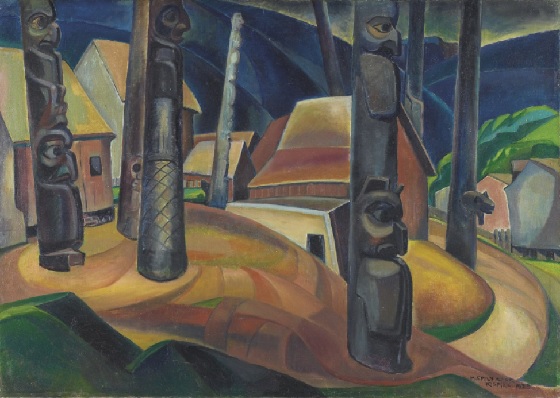
Emily Carr, 1871-1945
Kispiax Village, 1929
Oil on canvas
On loan from The Art Gallery of Ontario, Toronto, Canada
Today we feature a guest artist in our collection for Women’s History Month: Canadian Emily Carr, whose Kispiax Village (1929) is on loan to Crystal Bridges from the Royal Ontario Museum in Toronto, Canada.
The youngest of five children born to British parents who immigrated to Canada, Emily Carr (1871-1945) was the rebellious one in the family, often resisting the British traditions of her parents and the authority of her father in particular. Her career as an artist began in 1890, when she attended art school in San Francisco and emerged three years later as a watercolorist. She spent the next 16 years studying in the United States and London, a city that made her physically ill, and teaching at art schools in her hometown, Victoria. Then, in 1907, she and her sister visited Sitka, Alaska, where Carr first experienced totem poles.
The trip incited Carr’s deep, lifelong connection with First Nations people, culture, and art; but this was not Carr’s first time interacting with and painting Indigenous people. In 1899, the same year she left for London, Carr visited Ucluelet on Vancouver Island, where she met, drew, and painted the Nootka. There, she met the chieftain and was named Klee Wyck (laughing one) by the villagers. Most importantly, though, she recognized that the Nootka maintained a strong, spiritual relationship with nature, to which Carr strongly related. When she visited Sitka and saw the totem poles of the Tlingit, Carr recognized the possibility of their destruction and dedicated herself to recording the totem poles in her art.
Carr’s visits to Ucluelet and Sitka were the first in a long series of trips around the west coast of British Columbia that continued through Carr’s lifetime. She returned several times to Sitka and also journeyed to Alert Bay, Campbell River, the Kwakiutl villages in the south, North Vancouver reserves, and the Stanley Park rainforest, battling seasickness and jungle-like conditions. In 1910, she left for France for further study, where she took inspiration from Post-Impressionism, and created vibrant watercolors. Her paintings of totem poles now emphasized the eyes, staying true to the liveliness of nature and the spiritual meanings of the poles themselves.
Unfortunately, Carr’s work was not widely appreciated. She was perhaps the most advanced artist in Canada at the time, building a massive body of work, but her art—centering First Nations culture—failed to attract buyers in a society that oppressed Indigenous people. The period between 1913 and 1927 was the most grueling of Carr’s life, both financially and artistically. She became a landlady and bred Old English sheepdogs, and because of her poverty, her artistic output was limited almost exclusively to the Native-inspired pottery she sold in the tourist trade under the name Klee Wyck, which, she wrote in her journals, she did guiltily.
1927 brought both financial and artistic relief. The National Gallery of Canada in Ottawa chose Carr’s work as the focus of an exhibition on Canadian Native art, providing national attention and networking opportunities. It was through this exhibition that Carr met Mark Tobey, who introduced her to Cubism and Abstraction, as well as a group of Modernist Canadian landscape painters called the Group of Seven, most importantly Lawren Harris. Harris is credited with creating a clean, flat style of painting that he felt captured the spiritual element he found in the Canadian landscape.
Although critical of the sense of stillness in Harris’s work, Carr took inspiration from his style and changed her own to focus on simplified forms, grandeur of composition, and a more intense spiritual relationship with nature. Her personal beliefs evolved during this time as well, merging with the traditions of First Nations people to forge her own unique sense of spirituality. Rather than depicting totem poles, Carr now devoted her art to trees and a grand, sweeping sense of motion in nature, exaggerated further by an oil paint and gasoline mixture she invented to allow her to paint as fast as she could. Even the perspective of her work respects the landscape, the viewer often looking up, as though recognizing the immensity and power of nature.

Tree (spiralling upward), 1932 – 1933
oil on paper
Collection of the Vancouver Art Gallery, Emily Carr Trust
As her health began deteriorating near the end of her life, Carr was unable to travel as much as she wished. She became confined to a caravan called The Elephant, where she would paint surrounded by the many animals she adopted. Then, when she was unable even to paint, she turned her attention to writing, which she had done extensively all her life. She published three books before she died in 1945, including Klee Wyck (1941), a series of autobiographical stories that won the Governor General’s Literary Award. Four more books were published posthumously.

Emily Carr sits in her caravan, “the Elephant,” at the southwest end of Esquimalt Lagoon in 1934. Image F-07885 courtesy of the Royal BC Museum and Archives Photograph By Royal BC Museum and Archives
Although Carr’s relationship to Indigenous cultures was not perfect—and even, Carr admitted, problematic at times—she was dedicated to understanding First Nations people and worked passionately to portray the artistic and spiritual power of Indigenous cultures. Carr hoped to celebrate and legitimize Native art with her painting, confronting a society that marginalized First Nations people.



